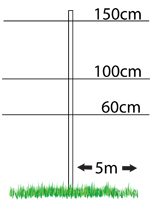Being fast moving animals, horses need a fence to be visible so they don't go charging into it and damage both themselves and the fence. This being the case,
polytape or
polyrope are the recommended conductors to use.
Conductor QualityThe qualities of these can vary as the more basic tape or rope may contain fewer and thinner conductors than the superior grades of fence line. This effectively means that it can't power as long a fence. If the electric fence has only to be a few hundred metres then it won't matter and a standard quality conductor will be fine.
Permanent Horse Fencing If the fencing is to be permanent then it's best to have wooden posts sunk into the ground and
insulators attached to hold the conductor in place. The
insulators prevent the current from earthing out and can be offset from the fence if necessary. For most permanent perimeter fencing, we'd recommend a
40mm diameter tape except in exposed areas where we'd recommend
20mm tape or a
rope. The reason being that 40mm tape can sometimes catch the wind and flap causing damage to itself.
The height, spacing and number of conductors depend largely upon the horse being contained. The more spirited the horse, the more lines of electric fencing you'll need. For all horses, a conductor at nose level is ideal as this will always be a reminder of the fence and once the horse has touched the electric fence, the barrier becomes not so much physical as psychological. The line around the 1m mark is really a backup to the higher line and it can prevent the horse from stretching under the main line. The additional visual presence only adds to the horses respect of the fence line.
Temporary Horse FencingPolyposts and
tape or
rope should be used here. One or two lines should deter the horse and the polyposts are very easily moved. For most horses, the 105cm posts are perfectly adaquate and are fine for strip grazing but for larger horses, the
tall posts give that extra element of security.
Energiser ChoiceFor a permanent fence and if mains power is present nearby, a
mains energiser is the best option. The power can be taken from the energiser to the fence (and the
earth stake) by
lead-out cable and all you need do is plug the energiser in and switch on.
Battery energisers are great if your fence is remote and the
12v energisers and leisure batteries are the most common. The battery is easily recharged but heavy to move about (Tip - By placing your 12v battery on a section of wood slightly off the ground you can extend the battery life by a few weeks). These are great for temporary fencing but if it's for seasonal use and strip grazing then the lighter
9v energisers are perfect. They use a dry battery which is contained within the box and the earth stake sits underneath the unit and holds it securely next to the fence. The batteries are non-rechargeable but will last a considerable time especially with those units with power saving features.
Horse Fencing KitsWe have put together some
kits which are perfect for novice and seasoned users alike. The
strip grazing kits use the
DB350B energiser which comes with 4 D cell batteries and can also run from a 12v battery - ideal if you're needing a very mobile fencing kit to strip graze a field or if you need something easy to pick up and take to provide a quick and effective fence at a show or similar. The
9v kits also come with a battery (
55Ah) to get you started. Please note, the 12v powered kits are stronger in power and recommended for well-insulated ponies like shetlands or if your horses are rugged in winter. The 12v kits do not come with a battery and you will need a 12v leisure batttery or similar to power the energiser. Please feel free to call us if you arre unsure which kit would suit you best or if would like ay further information or advice on horse fencing.

